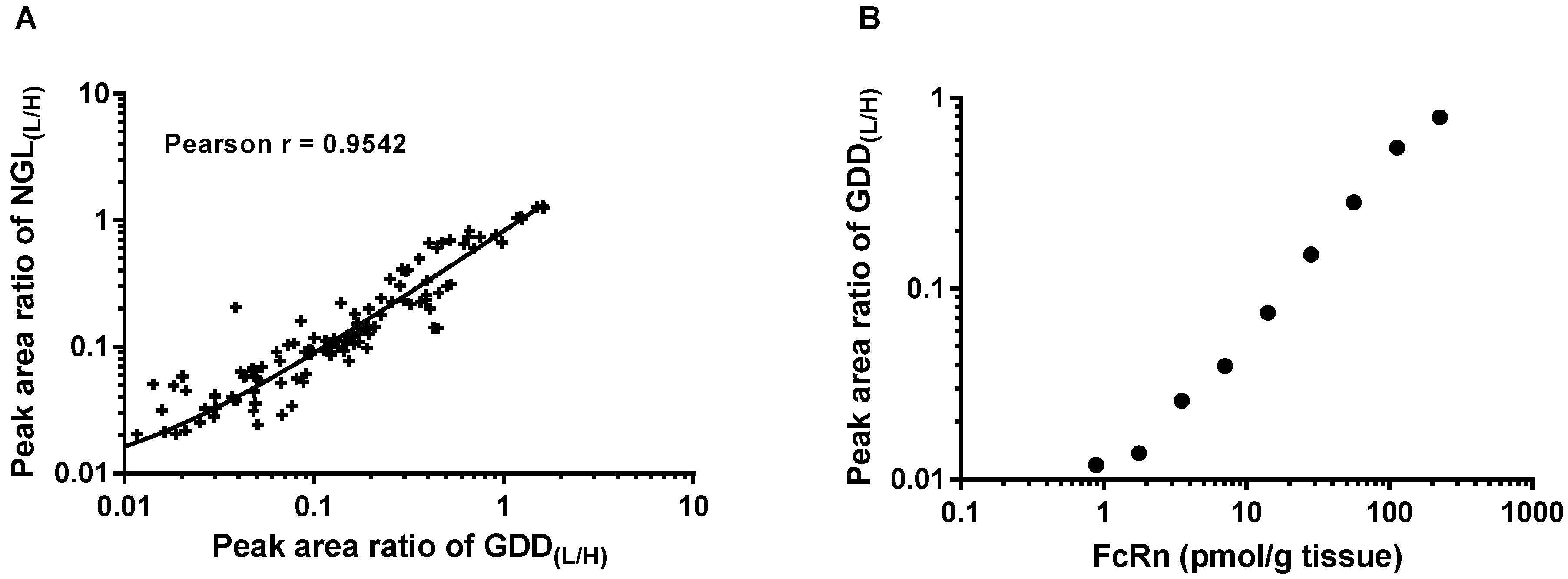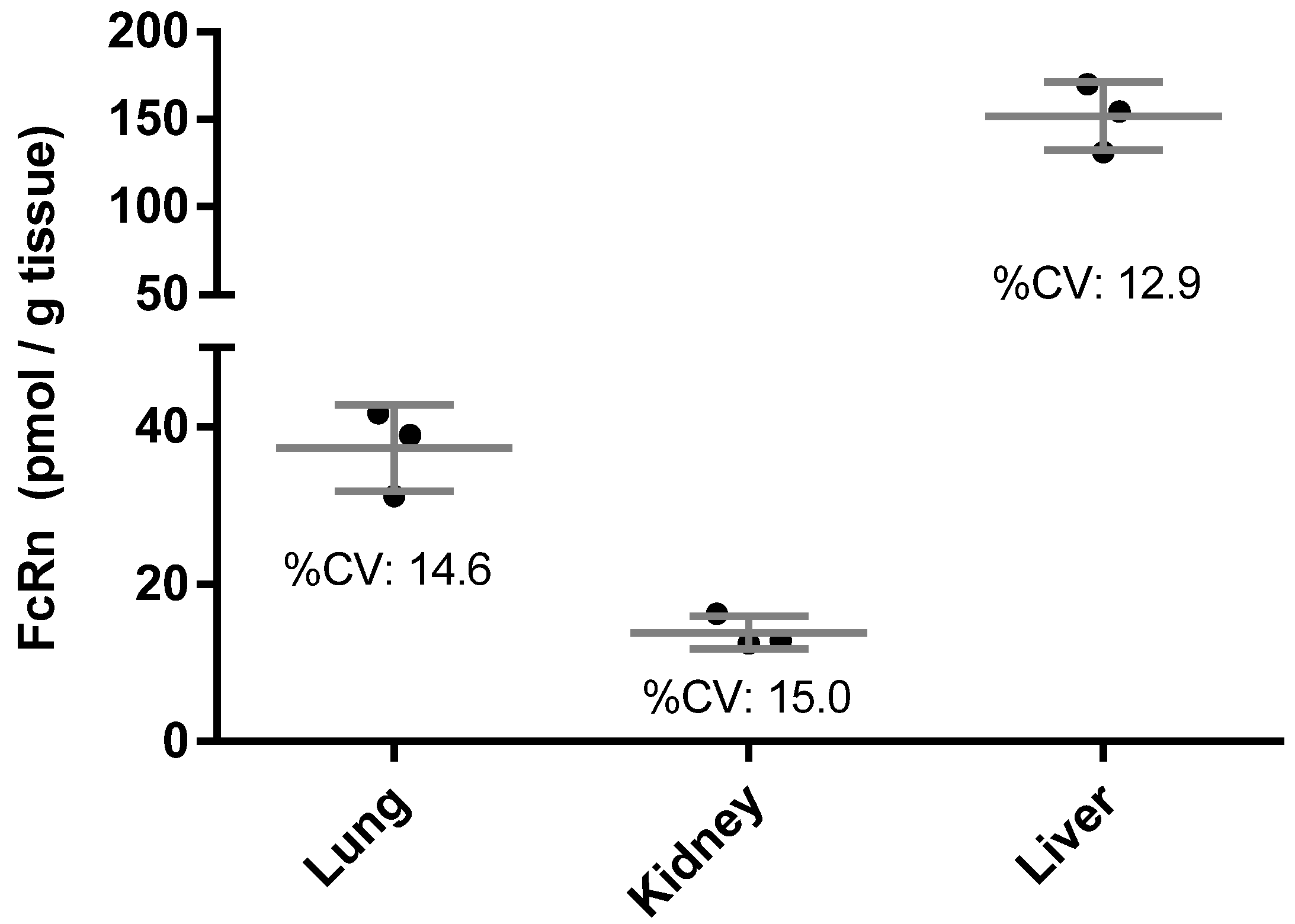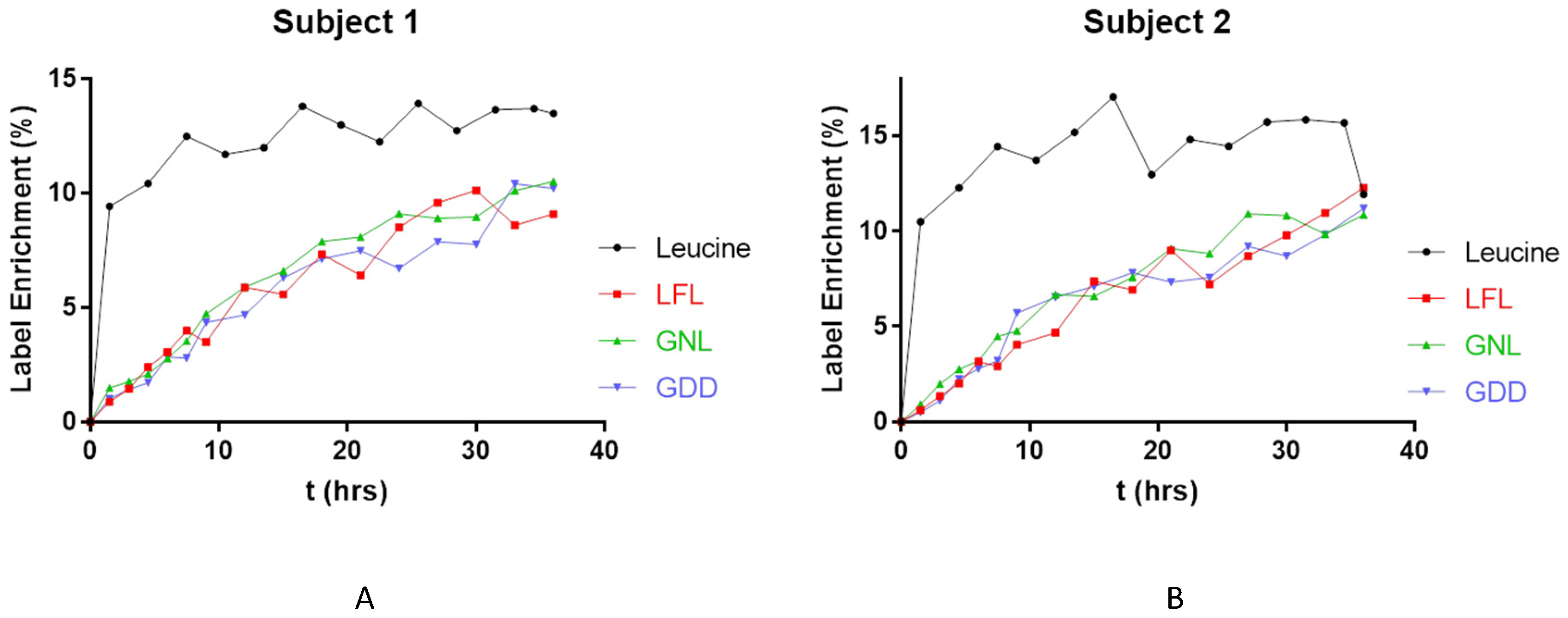Human FcRn Tissue Expression Profile and Half-Life in PBMCs
Abstract
1. Introduction
2. Materials and Methods
2.1. Rabbit Polyclonal anti Human FcRn Antibody Generation
2.2. Ligand Affinity Purification of Rabbit Polyclonal FcRn Antibody
2.3. Biotinylation of Ligand Affinity Purified Rabbit Polyclonal FcRn Antibody
2.4. FcRn Tissue Concentration Measurements
2.5. Heavy Leucine Pulse Labeling in Human Volunteers
2.6. FcRn Half-Life Measurement
3. Results and Discussions
Supplementary Materials
Author Contributions
Funding
Conflicts of Interest
References
- Kuo, T.T.; Aveson, V.G. Neonatal Fc receptor and IgG-based therapeutics. mAbs 2011, 3, 422–430. [Google Scholar] [CrossRef] [PubMed]
- Roopenian, D.C.; Akilesh, S. FcRn: The neonatal Fc receptor comes of age. Nat. Rev. Immunol. 2007, 7, 715–725. [Google Scholar] [CrossRef] [PubMed]
- Kamath, A.V. Translational pharmacokinetics and pharmacodynamics of monoclonal antibodies. Drug Discov. Today Technol. 2016, 21–22, 75–83. [Google Scholar] [CrossRef] [PubMed]
- Diao, L.; Meibohm, B. Tools for predicting the PK/PD of therapeutic proteins. Expert Opin. Drug Metab. Toxicol. 2015, 11, 1115–1125. [Google Scholar] [CrossRef] [PubMed]
- Luu, K.T.; Kraynov, E.; Kuang, B.; Vicini, P.; Zhong, W.Z. Modeling, simulation, and translation framework for the preclinical development of monoclonal antibodies. AAPS J. 2013, 15, 551–558. [Google Scholar] [CrossRef] [PubMed]
- Li, T.; Balthasar, J.P. FcRn Expression in Wildtype Mice, Transgenic Mice, and in Human Tissues. Biomolecules 2018, 8. [Google Scholar] [CrossRef] [PubMed]
- Latvala, S.; Jacobsen, B.; Otteneder, M.B.; Herrmann, A.; Kronenberg, S. Distribution of FcRn Across Species and Tissues. J. Histochem. Cytochem. 2017, 65, 321–333. [Google Scholar] [CrossRef] [PubMed]
- Haymann, J.P.; Levraud, J.P.; Bouet, S.; Kappes, V.; Hagege, J.; Nguyen, G.; Xu, Y.; Rondeau, E.; Sraer, J.D. Characterization and localization of the neonatal Fc receptor in adult human kidney. J. Am. Soc. Nephrol 2000, 11, 632–639. [Google Scholar] [PubMed]
- Borvak, J.; Richardson, J.; Medesan, C.; Antohe, F.; Radu, C.; Simionescu, M.; Ghetie, V.; Ward, E.S. Functional expression of the MHC class I-related receptor, FcRn, in endothelial cells of mice. Int. Immunol. 1998, 10, 1289–1298. [Google Scholar] [CrossRef] [PubMed]
- Ober, R.J.; Martinez, C.; Vaccaro, C.; Zhou, J.; Ward, E.S. Visualizing the site and dynamics of IgG salvage by the MHC class I-related receptor, FcRn. J. Immunol. 2004, 172, 2021–2029. [Google Scholar] [CrossRef] [PubMed]
- Fan, Y.Y.; Neubert, H. Quantitative Analysis of Human Neonatal Fc Receptor (FcRn) Tissue Expression in Transgenic Mice by Online Peptide Immuno-Affinity LC-HRMS. Anal. Chem. 2016, 88, 4239–4247. [Google Scholar] [CrossRef] [PubMed]
- Farrokhi, V.; Chen, X.; Neubert, H. Protein Turnover Measurements in Human Serum by Serial Immunoaffinity LC-MS/MS. Clin. Chem. 2018, 64, 279–288. [Google Scholar] [CrossRef] [PubMed]
- Razavi, M.; Farrokhi, V.; Yip, R.; Anderson, N.L.; Pearson, T.W.; Neubert, H. Measuring the Turnover Rate of Clinically Important Plasma Proteins using an Automated SISCAPA Workflow. Clin. Chem. 2019. [Google Scholar] [CrossRef] [PubMed]
- Farrokhi, V.; Chabot, J.R.; Neubert, H.; Yang, Z. Assessing the Feasibility of Neutralizing Osteopontin with Various Therapeutic Antibody Modalities. Sci. Rep. 2018, 8, 7781. [Google Scholar] [CrossRef] [PubMed]
- Lassman, M.E.; McAvoy, T.; Lee, A.Y.; Chappell, D.; Wong, O.; Zhou, H.; Reyes-Soffer, G.; Ginsberg, H.N.; Millar, J.S.; Rader, D.J. Practical immunoaffinity-enrichment LC-MS for measuring protein kinetics of low-abundance proteins. Clin. Chem. 2014, 60, 1217–1224. [Google Scholar] [CrossRef] [PubMed]
- Neubert, H.; Muirhead, D.; Kabir, M.; Grace, C.; Cleton, A.; Arends, R. Sequential protein and peptide immunoaffinity capture for mass spectrometry-based quantification of total human beta-nerve growth factor. Anal. Chem. 2013, 85, 1719–1726. [Google Scholar] [CrossRef] [PubMed]
- Palandra, J.; Finelli, A.; Zhu, M.; Masferrer, J.; Neubert, H. Highly specific and sensitive measurements of human and monkey interleukin 21 using sequential protein and tryptic peptide immunoaffinity LC-MS/MS. Anal. Chem. 2013, 85, 5522–5529. [Google Scholar] [CrossRef] [PubMed]
- Zhu, X.; Meng, G.; Dickinson, B.L.; Li, X.; Mizoguchi, E.; Miao, L.; Wang, Y.; Robert, C.; Wu, B.; Smith, P.D.; et al. MHC class I-related neonatal Fc receptor for IgG is functionally expressed in monocytes, intestinal macrophages, and dendritic cells. J. Immunol. 2001, 166, 3266–3276. [Google Scholar] [CrossRef] [PubMed]
- Mi, W.; Wanjie, S.; Lo, S.T.; Gan, Z.; Pickl-Herk, B.; Ober, R.J.; Ward, E.S. Targeting the neonatal fc receptor for antigen delivery using engineered fc fragments. J. Immunol. 2008, 181, 7550–7561. [Google Scholar] [CrossRef] [PubMed]
- Fan, Y.Y.; Avery, L.B.; Wang, M.; O’Hara, D.M.; Leung, S.; Neubert, H. Tissue expression profile of human neonatal Fc receptor (FcRn) in Tg32 transgenic mice. mAbs 2016, 8, 848–853. [Google Scholar] [CrossRef] [PubMed]
- Akilesh, S.; Christianson, G.J.; Roopenian, D.C.; Shaw, A.S. Neonatal FcR expression in bone marrow-derived cells functions to protect serum IgG from catabolism. J. Immunol. 2007, 179, 4580–4588. [Google Scholar] [CrossRef] [PubMed]
- Telleman, P.; Junghans, R.P. The role of the Brambell receptor (FcRB) in liver: Protection of endocytosed immunoglobulin G (IgG) from catabolism in hepatocytes rather than transport of IgG to bile. Immunology 2000, 100, 245–251. [Google Scholar] [CrossRef] [PubMed]
- Eigenmann, M.J.; Fronton, L.; Grimm, H.P.; Otteneder, M.B.; Krippendorff, B.F. Quantification of IgG monoclonal antibody clearance in tissues. mAbs 2017, 9, 1007–1015. [Google Scholar] [CrossRef] [PubMed]
- Avery, L.B.; Wang, M.; Kavosi, M.S.; Joyce, A.; Kurz, J.C.; Fan, Y.Y.; Dowty, M.E.; Zhang, M.; Zhang, Y.; Cheng, A.; et al. Utility of a human FcRn transgenic mouse model in drug discovery for early assessment and prediction of human pharmacokinetics of monoclonal antibodies. mAbs 2016, 8, 1064–1078. [Google Scholar] [CrossRef] [PubMed]
- Singh, S.A.; Andraski, A.B.; Pieper, B.; Goh, W.; Mendivil, C.O.; Sacks, F.M.; Aikawa, M. Multiple apolipoprotein kinetics measured in human HDL by high-resolution/accurate mass parallel reaction monitoring. J. Lipid Res. 2016, 57, 714–728. [Google Scholar] [CrossRef] [PubMed]




| Tissue | Dilution/Spike | Precision (%CV) ** | Relative Accuracy % *** | ||||||
|---|---|---|---|---|---|---|---|---|---|
| Intra-Batch 1 | Intra-Batch 2 | Intra-Batch 3 | Inter-Batch | Intra-Batch 1 | Intra-Batch 2 | Intra-Batch 3 | Inter-Batch | ||
| Human Lung | * Dilute 4 fold | 1.0 | 6.5 | 13.1 | 6.9 | −2.3 | 23.7 | 15.3 | 12.2 |
| * Dilute 2 fold | 4.5 | 10.0 | 5.6 | 6.7 | −5.7 | −8.2 | −10.7 | −8.2 | |
| Endogenous | 5.9 | 7.0 | 6.2 | 6.3 | n/a | n/a | n/a | n/a | |
| Spike 100 ng/mL rhFcRn | 10.0 | 10.8 | 7.6 | 9.5 | 22.2 | 11.8 | 11.9 | 15.3 | |
| Human Kidney | * Dilute 2 fold | 9.5 | 5.7 | 6.9 | 7.4 | 23.2 | 6.5 | 2.8 | 10.8 |
| Endogenous | 11.0 | 10.9 | 12.2 | 11.4 | n/a | n/a | n/a | n/a | |
| Spike 100 ng/mL rhFcRn | 10.6 | 6.8 | 8.6 | 8.7 | 12.8 | −7.8 | −8.4 | −1.1 | |
| Admix | * Dilute 2 fold (hLung + hKidney) | 6.4 | 12.9 | 13.0 | 10.7 | 3.4 | −13.7 | −11.5 | −7.3 |
| Endogenous (hLung + hKindey) | 10.3 | 6.7 | 6.6 | 7.9 | −10.8 | −24.9 | −19.9 | −18.5 | |
| Tissue Type | FcRn Expression (pmol/g Tissue) (Individual Measurement Listed) |
|---|---|
| Spleen | 230.7 ± 56.4 (178.3; 183.2; 308.2; 214.9; 268.8) |
| Lymph node | 91.7 ± 33.4 (124.9; 78.2; 128.7; 73.2; 53.3) |
| Liver | 89.5 ± 42.3 (67.3; 37.0; 81.3; 116.6; 145.2) |
| Lung | 85.2 ± 37.3 (55.0; 130.7; 97.1; 103.8; 39.5) |
| Kidney | 48.3 ± 11.7 (35.3; 38.9; 47.6; 56.2; 63.5) |
| Stomach | 40.1 ± 8.9 (40.2; 31.3; 36.7; 37.4; 54.9) |
| Colon | 39.0 ± 17.0 (20.5; 45.4; 21.3; 55.9; 51.9) |
| Small bowel | 32.1 ± 18.5 (56.3; 11.8; 27.5; 32.6; bloq) |
| Skin | 24.6 ± 14.5 (42.1; 16.9; 38.2; 10.7; 14.8) |
| Brain | 8.1 ± 7.7 (19.4; 6.2; 4.0; 2.9; bloq) |
| Adipose | 7.6 ± 4.5 (5.3; 15.3; 6.3; 3.6; 7.5) |
| Skeletal muscle | 6.5 ± 4.0 (12.4; 5.3; 7.8; 1.6; 5.6) |
| Heart | 3.3 ± 0.7 (4.2; 3.6; 2.3; 3.3; 3.4) |
| PBMCs | 0.22 ± 0.03 (pmol/million cells) (0.25; 0.23; 0.19) |
| Peptide | Light | Heavy | ||
|---|---|---|---|---|
| Q1 m/z | Q3 m/z | Q1 m/z | Q3 m/z | |
| LFL | 434.25 [M2+] | 607.34 [M1+] y5 | 437.26 [M2+] | 613.36 [M1+] y5 |
| GDD | 1006.49 [M2+] | 1241.60 [M1+] y12, 1043.50 [M1+] y10 | 1009.50 [M2+] | 1247.62 [M1+] y12, 1049.52 [M1+] y10 |
| GNL | 373.69 [M2+] | 575.31 [M1+] y4, 462.23 [M1+] y3 | 376.70 [M2+] | 581.33 [M1+] y4, 462.23 [M1+] y3 |
| Human Subject | ksyn | Half-Life (t½) in h. |
|---|---|---|
| Subject 1 | 0.065 | 10.6 |
| Subject 2 | 0.060 | 11.6 |
© 2019 by the authors. Licensee MDPI, Basel, Switzerland. This article is an open access article distributed under the terms and conditions of the Creative Commons Attribution (CC BY) license (http://creativecommons.org/licenses/by/4.0/).
Share and Cite
Fan, Y.-Y.; Farrokhi, V.; Caiazzo, T.; Wang, M.; O’Hara, D.M.; Neubert, H. Human FcRn Tissue Expression Profile and Half-Life in PBMCs. Biomolecules 2019, 9, 373. https://doi.org/10.3390/biom9080373
Fan Y-Y, Farrokhi V, Caiazzo T, Wang M, O’Hara DM, Neubert H. Human FcRn Tissue Expression Profile and Half-Life in PBMCs. Biomolecules. 2019; 9(8):373. https://doi.org/10.3390/biom9080373
Chicago/Turabian StyleFan, Yao-Yun, Vahid Farrokhi, Teresa Caiazzo, Mengmeng Wang, Denise M. O’Hara, and Hendrik Neubert. 2019. "Human FcRn Tissue Expression Profile and Half-Life in PBMCs" Biomolecules 9, no. 8: 373. https://doi.org/10.3390/biom9080373
APA StyleFan, Y.-Y., Farrokhi, V., Caiazzo, T., Wang, M., O’Hara, D. M., & Neubert, H. (2019). Human FcRn Tissue Expression Profile and Half-Life in PBMCs. Biomolecules, 9(8), 373. https://doi.org/10.3390/biom9080373





